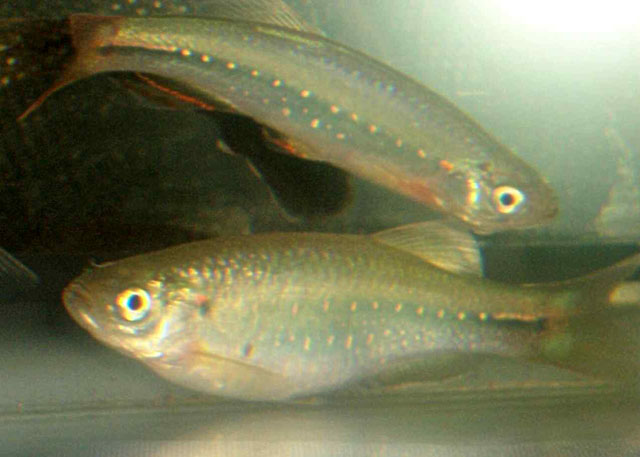| Danionidae (Danios), subfamily: Danioninae |
| 6.75 cm SL (male/unsexed) |
|
benthopelagic; freshwater |
| Asia: Rakhine Yoma in Myanmar. |
|
Dorsal soft rays (total): 10-10; Anal soft rays: 15-16; Vertebrae: 36-37. Danio feegradei is distinguished from all congeners except D. bsconditus by the presence of a large, elongate black spot at the base of the caudal fin (vs. absence; or minute and inconspicuous in D. jaintianensis, D. choprae and D. flagrans; or small, round and margined by a lighter zone in D.
erythromicron), a small black or grey cleithral spot and a light (orange in life) spot immediately above the cleithral spot (vs. absent; or present, large and not bordered by light spot in D. assamila, D. catenatus, D. concatenatus, D. dangila, and D. sysphigmatus; or minute, not separated from P stripe and not associated with light spot in D. meghalayensis). It differs from all Danioexcept D. absconditus, D. assamila, D. catenatus, D. concatenatus, D. dangila, D. meghalayensis and D. sysphigmatus by the presence of a complete lateral line (vs. abbreviated or absent) and 14–16 circumpeduncular scales (vs. 10–12).
It can be diagnosed from D. absconditus by the absence of dark vertical bars on abdominal sides (vs. presence of about 7–11 distinct dark bars), and presence of a dark area along the middle of the side, with two or three irregular horizontal
rows of white dots (vs. absence of continuous dark area on anterior side and absence of white dots on the side) (Ref. 106271). |
| Found in small coastal streams (Ref. 106271). |
|
Not Evaluated (N.E.) Ref. (130435)
|
| harmless |
Source and more info: www.fishbase.org. For personal, classroom, and other internal use only. Not for publication.

